This post may contain affiliate links. Please see our disclosure policy.
Apricot butter is a simple and delicious way to capture the flavor of sweet summer apricots (no peeling required). With just a few ingredients and some slow simmering, you’ll end up with a rich, spreadable preserve that’s perfect for breakfast toast or homemade gifts.
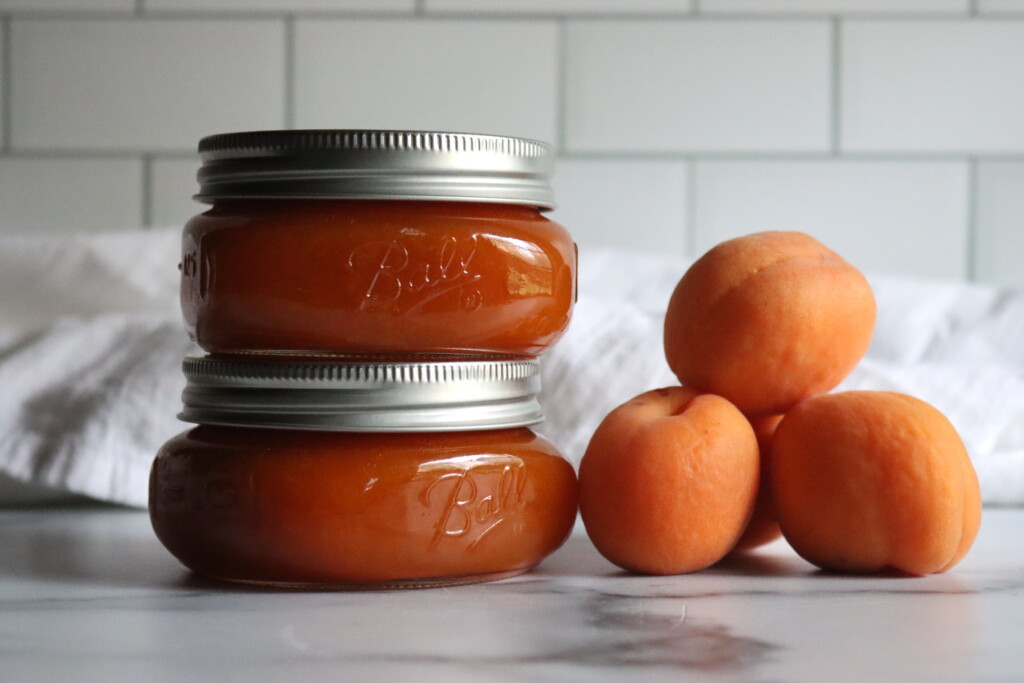
Homemade apricot butter is one of the simplest ways to preserve fresh apricots in season. It has less sugar than jam, and more fruit flavor, plus you don’t have to worry about adding pectin. All you need is fresh fruit, sugar and a splash of lemon juice to really make the flavor pop.
I adapted this recipe from the Ball Blue Book of Preserving and the Ball Complete Book of Home Preserving, both of which have similar recipes. The main difference is, I skip the peeling step.
Why?
Because those thin apricot skins practically melt into the preserve, and skipping the peeling step actually makes the flavor and color better. It’s one of those rare cases where the easy way really is the best way.

I’ve tried it both ways, peeled and unpeeled, and there’s just no contest. When you leave the skins on, they break down beautifully during cooking, especially if you use an immersion blender to finish the puree. No noticeable texture—just silky smooth apricot butter. And peeling apricots? That’s a race against oxidation. They brown in the blink of an eye once the skins come off, and the only way to prevent it is with a ton of lemon juice… which dulls the fruit flavor.
By skipping the peeling step, you avoid all that mess, preserve the bright orange color, and retain more of the aromatic compounds that make apricots smell and taste like pure summer. (It’s the same story with quince—some of the best flavor lives in the peel.)
If you’ve got a pile of ripe apricots and a couple of hours, apricot butter is a great way to preserve the harvest. Here’s how to make it.
(FYI, in terms of canning safety, it’s perfectly fine to leave the peels on apricots in all canning recipes, and that’s actually how the University of Oregon Extension recommends putting them up.)
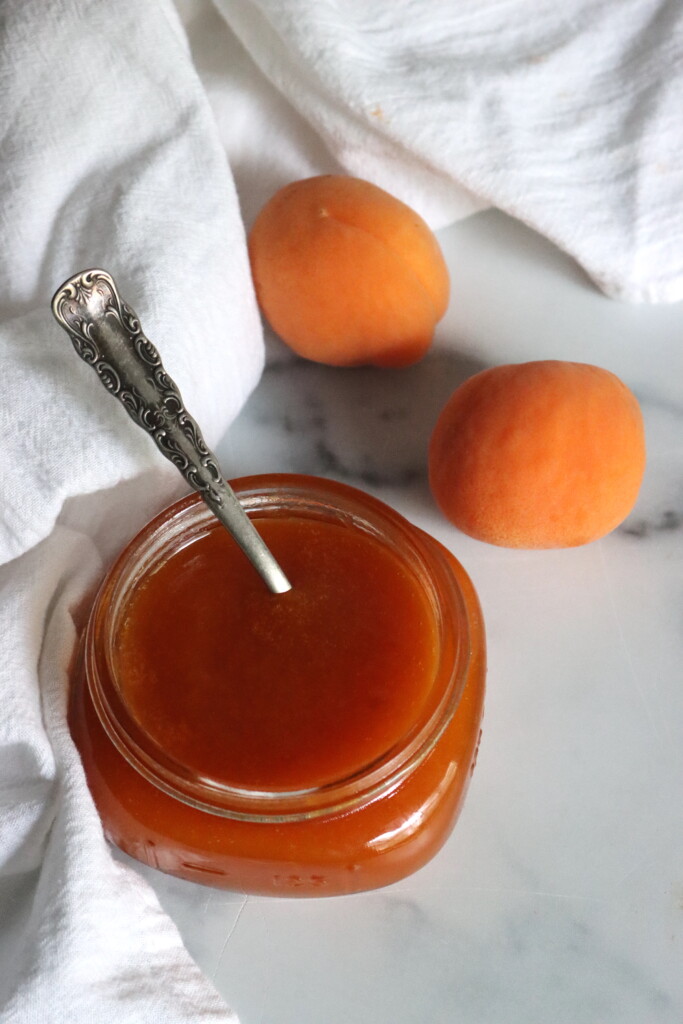
Ingredients for Apricot Butter
At its core, apricot butter is made with just a few simple ingredients. This recipe sticks closely to the classic Ball tested version, with the one big improvement—no peeling needed.
You’ll need:
- Apricots – Fresh, ripe, and flavorful. You can use ones that are a bit soft or slightly blemished, so long as they’re still fresh and flavorful.
- Water – Just enough to get the apricots started simmering without scorching.
- Sugar – Standard granulated sugar is traditional and helps the butter thicken properly and keep well.
- Lemon Juice – This adds brightness and balances the sweetness, but it’s not required for safety in this recipe.
For a spiced apricot butter recipe, you can add warming spices like cinnamon or cardamom, or even a splash of vanilla at the end. It’s also really good with a few tablespoons of brandy or whiskey.
But even plain, apricot butter is downright delicious, and that’s how I make it most of the time so that it’s more versatile.

How to Make Apricot Butter
The process starts by halving and pitting your apricots—no peeling necessary. Coarsely chop into small-ish pieces, around 1 inch or so. You don’t have to be exact here, but chopping will help them cook a bit faster.
Combine them with a bit of water in a large pot and simmer until the fruit is soft and falling apart. This usually takes around 20 minutes.
Once softened, puree the fruit until smooth (but don’t go crazy, you don’t need to completely liquify them). An immersion blender is the easiest tool here—it lets you puree right in the pot with minimal cleanup. Otherwise, use a food processor or food mill in batches.
Return the puree to the pot and stir in the sugar and lemon juice. From here, it’s all about low, slow simmering. On the stovetop, expect the butter to take about 1 to 2 hours to reach a thick, spreadable consistency—usually closer to 1½ hours. Stir frequently as it cooks down, especially toward the end when it’s more likely to stick.
If you’d rather not hover over the stove, this can be done in a crock pot on high. Expect the cook time to be 3 to 4 hours, but it’s much lower maintenance.
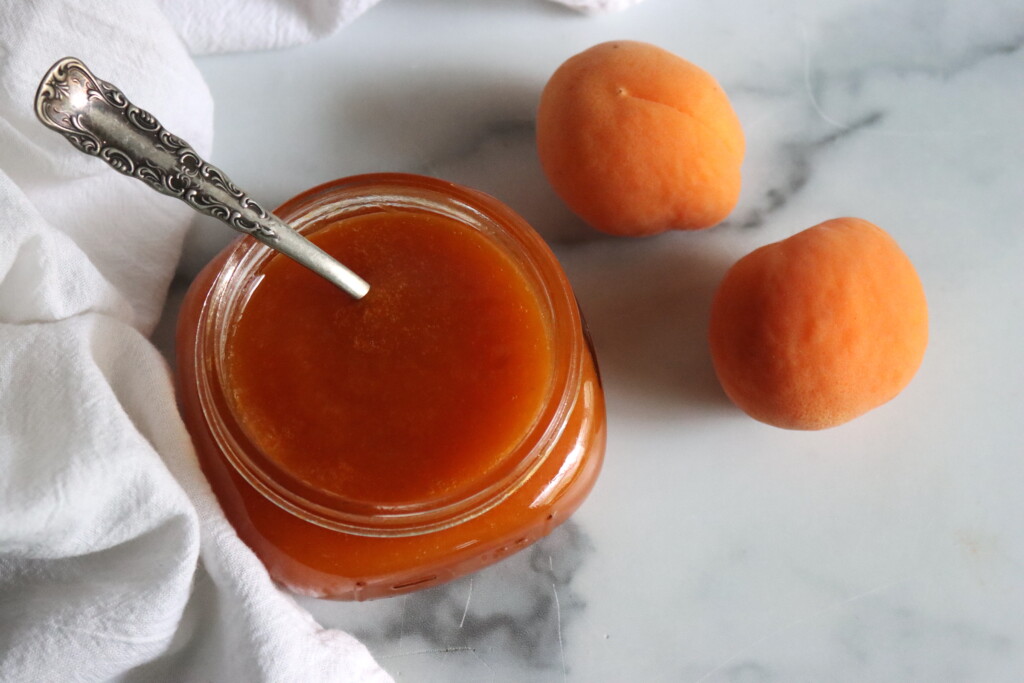
Canning Apricot Butter
When the apricot butter is thick and holds its shape on a spoon, it’s time to can. Prepare your water bath canner, sterilize your jars, and warm your lids and rings.
Ladle the hot butter into half-pint or pint jars, leaving ¼ inch headspace. Wipe the rims, apply the lids, and process in a boiling water bath for 10 minutes (adjusting for altitude—see below).
Once processed, remove the jars and let them cool completely. Check seals after 24 hours. Store any unsealed jars in the fridge and use within a few weeks. Properly sealed jars can be stored in a cool, dark pantry for up to a year.
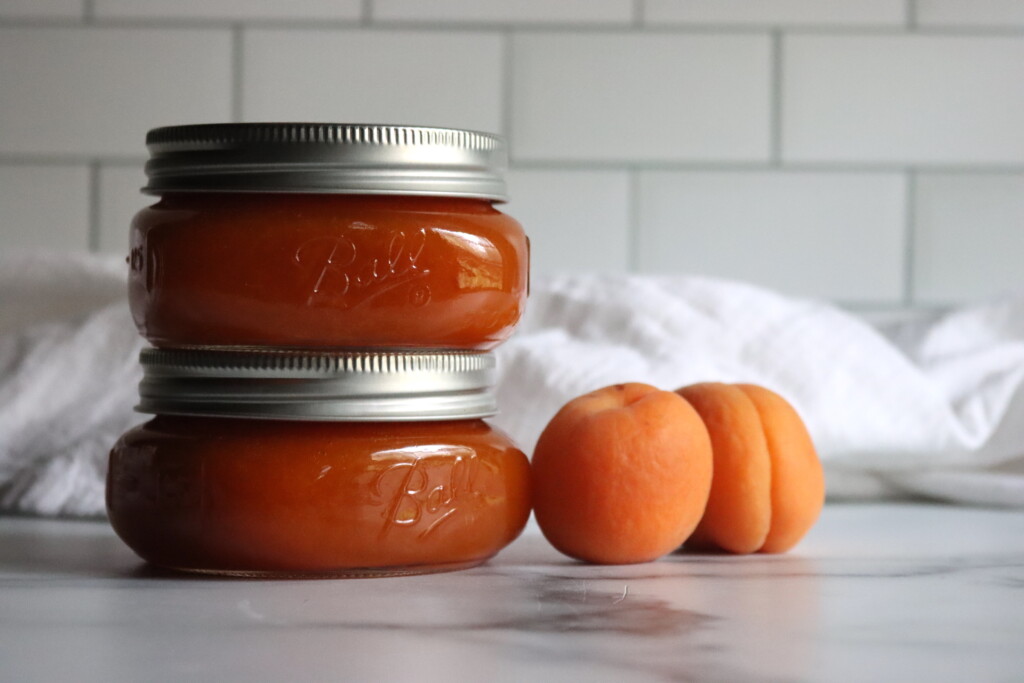
Altitude Adjustments
If you live above 1,000 feet in elevation, you’ll need to adjust your processing time to ensure safety. Here are the adjustments for this recipe:
- 1,001 to 3,000 feet: 15 minutes
- 3,001 to 6,000 feet: 20 minutes
- 6,001 to 8,000 feet: 25 minutes
- 8,001 to 10,000 feet: 30 minutes
These times apply to both pint and half-pint jars.
Using Apricot Butter
Apricot butter isn’t just for toast—though it’s absolutely perfect on a warm slice of sourdough. This smooth, tangy spread works beautifully in both sweet and savory dishes.
Try using it as a filling for thumbprint cookies or linzer-style sandwich cookies. It also makes a delicious swirl in plain yogurt or oatmeal, adding natural sweetness and a burst of fruit flavor. For breakfast, spoon it over pancakes, waffles, or crepes, or layer it into a parfait with granola and fresh fruit.
If you’re feeling creative, apricot butter can be brushed onto grilled meats as a glaze, especially chicken or pork. I actually have another recipe for Apricot BBQ Sauce that gives you a bit of sweet tang on meat, but this butter recipe would work for a simple glaze too.
It also pairs well with cheese—try serving a dollop alongside soft goat cheese or sharp cheddar on a snack board.
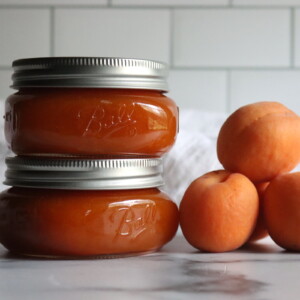
Apricot Butter
Equipment
Ingredients
- 2 lbs Apricots, halved, pitted and diced (about 16 to 24 medium)
- ½ cup Water
- 3 cups Sugar
- 2 Tbsp Lemon Juice, fresh or bottled, for flavor—not preservation
Instructions
- Wash the apricots under cold running water and drain well. Halve, pit and then coarsely chop the fruit. No need to peel them—the skins dissolve during cooking and enhance the flavor.
- In a large stainless steel saucepan, combine the apricots and water. Bring to a boil over medium-high heat. Reduce heat and simmer gently, stirring occasionally, for about 20 minutes, or until the apricots are very soft.
- Use an immersion blender directly in the pot to puree the mixture until smooth, or transfer in batches to a food mill or food processor. You should have about 6 cups of apricot puree at this stage.
- Return the puree to the pot (or transfer to a crockpot if using that method). Add the sugar and lemon juice, stirring until the sugar dissolves completely.
- Bring the mixture to a boil over medium-high heat, then reduce to the lowest heat and simmer uncovered, stirring frequently, until the butter thickens and holds its shape on a spoon. This takes 1 to 2 hours on the stovetop, usually closer to 1½ hours. Stir often to prevent scorching, especially toward the end.
- Crockpot option: Cook on high for 3 to 4 hours, uncovered, until thick. Stir occasionally, but it’s less prone to burning in a slow cooker.
- When the apricot butter is nearly done, prepare a water bath canner, sterilize your jars, and warm your lids and rings.
- Ladle the hot butter into jars, leaving ¼ inch headspace. Wipe rims, apply lids and rings, and process in a boiling water bath for 10 minutes (for both half-pints and pints). Adjust processing time for altitude as needed.
Notes
- If peeling: Blanch apricots in boiling water for 30–60 seconds, then transfer to cold water. Peel, halve, and pit. But honestly, I don’t recommend it—the flavor and color are better without peeling.
- Pureeing: An immersion blender is by far the easiest and least messy option.
- Sugar adjustments: You can reduce the sugar slightly, but the consistency and yield may be affected.
- Storage: Store sealed jars in a cool, dark place for up to a year. Refrigerate after opening.
- 1,001 to 3,000 feet: 15 minutes
- 3,001 to 6,000 feet: 20 minutes
- 6,001 to 8,000 feet: 25 minutes
- 8,001 to 10,000 feet: 30 minutes
Nutrition
Nutrition information is automatically calculated, so should only be used as an approximation.
Apricot Canning Recipes
If you’ve got more apricots to work with, don’t stop at apricot butter! You’ll find plenty of ways to preserve them in my other tested apricot canning recipes:
- Canning Apricots – A simple way to keep whole apricots shelf-stable and ready for desserts or snacking.
- Apricot Pie Filling – A ready made pie in a jar!
- Apricot Jam – A classic preserve with a bright, tangy flavor and just the right set.
- Apricot Salsa – Yes! You really can make an amazing fruit salsa with apricots!
Fruit Butter Recipes
Looking for other fruit butter recipe ideas? Try these smooth, spreadable preserves next:
- Peach Butter – A rich, summery spread made with ripe peaches and no added pectin.
- Apple Butter – A fall favorite that’s slow-cooked to caramelized perfection.
- Pear Butter – Delicately sweet and perfect on pancakes, toast, or stirred into yogurt.
Each one follows a similar simple process—fruit, sugar, time, and a bit of care. Once you’ve made one fruit butter, you’ll be hooked.
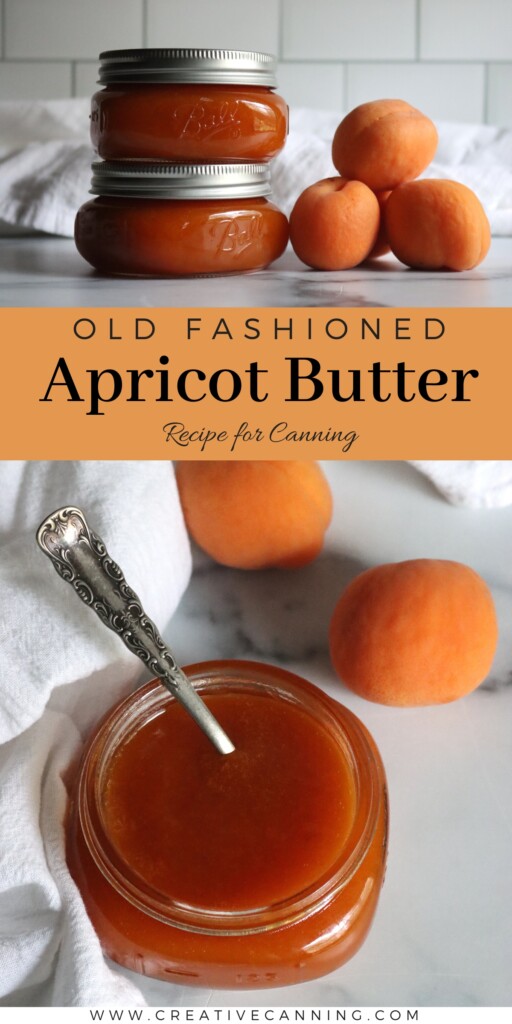
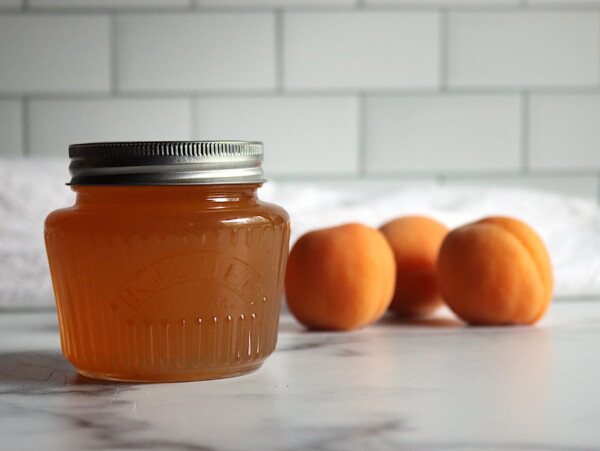

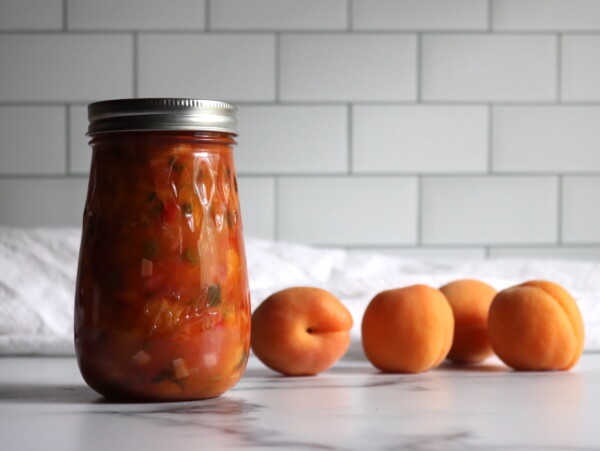

This one is hands down my favorite apricot preserve! I love it more than jam, and it has a silky smooth texture that’s perfect for spreading, but without all the sugar of jam. So darn good!
Making apricot butter
What amount of warning spices would you recommend for this recipe?
I tend to like very mildly spiced things, so I’d stick with no more than 1 tsp of dried spices in this recipe. What might be better, in my opinion, is putting whole warming spices in a spice bag (like whole cinnamon, allspice and cloves) and then cooking them in the spice bag with the apricots until it’s done (then removing the spice bag). In that case, I’d use 1 cinnamon sick, and a few whole allspice and clove.